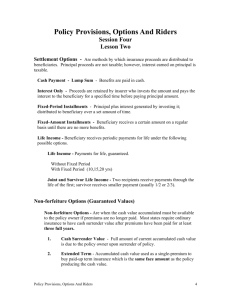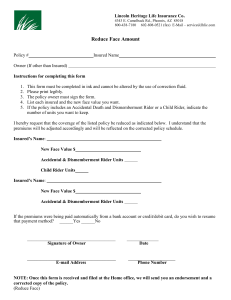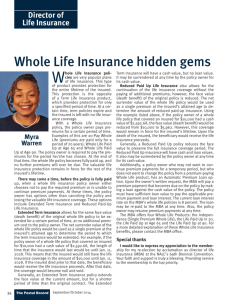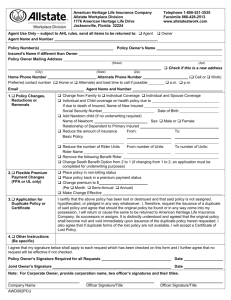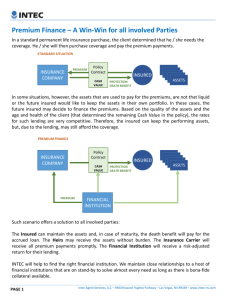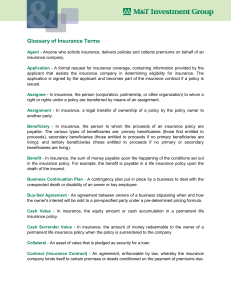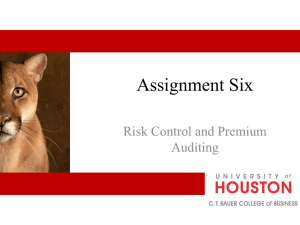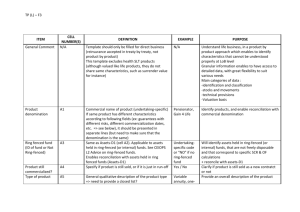Consumer Guide to Life Insurance - North Carolina Department of
advertisement
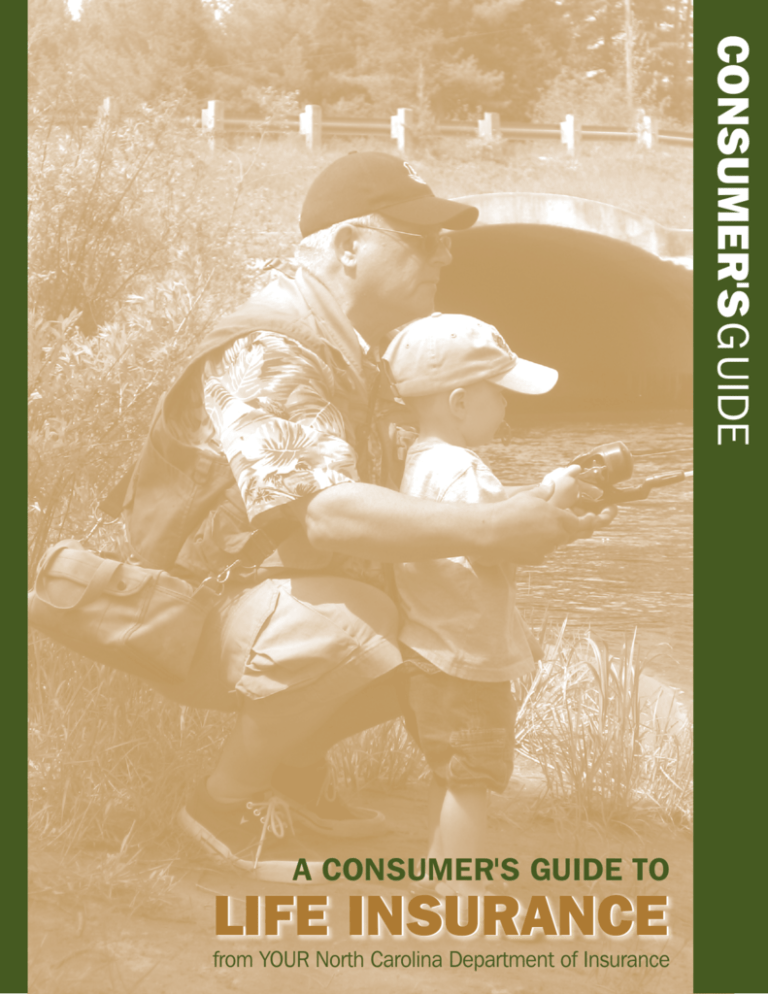
CONSUMER'SGUIDE A CONSUMER'S GUIDE TO LIFE INSURANCE from YOUR North Carolina Department of Insurance A MESSAGE FROM YOUR INSURANCE COMMISSIONER Greetin gs, Choosin g can also a life insurance b p of Insur e a complicate olicy is an imp ance is d and c ortant d he o e insuran ce optio re to help you nfusing one. Yo cision, and it ns you h ur Depa better u that is b nd rtm av es situation t for you. This e and to help y erstand the typ ent gu es of life ou to ch o o types of r every type o ide, while not f life ins intende ose the produc life insu ur d t ra informa tion to b nce most peo ance policy, co to cover every p v e helpfu le enco choices ers the un ba . l as you contem ter. I hope you sic plate yo If you h ur life in find this ave furt surance he of insur ance, yo r questions ab out life u at www in .ncdoi.c can call us at 800-54 surance or any om 6-5664 or visit o other type ur Web site Sincere ly, Wayne Goodw in Insuran ce Com mission er TABLE OF CONTENTS CONSUMER'S GUIDE TO LIFE INSURANCE Glossary of Insurance Related Terms............................................................................................... 1 Why Buy Life Insurance.................................................................................................................. 2 Term Life Insurance......................................................................................................................... 3 Permanent Life Insurance................................................................................................................ 4 Term Life and Permanent Life Insurance Comparisons..................................................................... 6 Standard Policy Provisions............................................................................................................... 7 Optional Policy Provisions............................................................................................................... 8 Shopping for Life Insurance............................................................................................................. 9 Applying for Life Insurance........................................................................................................... 14 Collecting Death Benefits.............................................................................................................. 15 Life Insurance Tips........................................................................................................................ 17 Frequently Asked Questions.......................................................................................................... 18 Consumer Services and Complaints.............................................................................................. 19 Life Insurance Needs Worksheet................................................................................................... 20 Consumer Complaint Form........................................................................................................... 21 IF YOU HAVE QUESTIONS... The Consumer Services Division of the Department of Insurance is here to help. 800-546-5664 919-807-6750 919-715-0319 919-733-0085 Toll free Outside of North Carolina TDD (Telephone Device for Deaf Callers) Fax You can find additional information as well as a downloadable copy of our complaint form on the North Carolina Department of Insurance Web site at www.ncdoi.com. North Carolina Department of Insurance 430 North Salisbury Street 1201 Mail Service Center Raleigh, NC 27699-1201 www.ncdoi.com INSURANCE TERMS GLOSSARY Evidence of Insurability Proof that a person is an acceptable risk to the insurance company. Face Value (Face Amount) The initial amount of death benefit provided by the policy. The actual death benefit may be higher or lower depending on the options selected, outstanding policy loans or premium owed. Insurable Interest The likelihood that a genuine loss would occur to the beneficiary/owner of a life insurance contract in the event of the insured's death. Insured The person on whose life an insurance policy is written. Lapse Termination of a policy because of failure to pay the premium. Mortality Table A statistical table showing the probability of death at each age. Policyowner The person or party who owns an insurance policy. The policyowner is often the insured person, but could be someone different. The policyowner is the only person who can make changes to a policy. Policy The printed contract issued to the policyowner which sets forth and states the terms of coverage. Premium The amount paid for an insurance policy. Reinstatement The restoration of a lapsed policy to its original premium-paying status. The company may require evidence of insurability and all past due premiums plus interest. Surrender Voluntary cancellation of a policy for its cash value. Surrender Charges Contractual charges imposed by an insurance company in the event of early policy cancellation. Underwriter The person who reviews applications for insurance and decides if the applicant is an acceptable risk to the company. 1 TYPES OF MY LIFE INSURANCE WHAT ARE OPTIONS? All life insurance is not the same. Life insurance can be divided into two basic categories — “term” and “permanent”. Term life insurance provides coverage for a specific period of time, while permanent life insurance provides coverage for the insured person’s entire life. The following pages explain the features of term and permanent life insurance policies, and also compare the two so you can better understand what each type of coverage offers. Later in this guide you will find a worksheet to help you evaluate your needs and choose a policy type that meets those needs. Both types pay what is known as a death benefit, which is the amount of money paid out upon the insured’s death. This money is paid to the person or persons designated by the insured. These people are known as the beneficiaries. As always, if you have questions about the types of life insurance available, you can call the Department of Insurance at 1-800-546-5664. DO I REALLY NEED LIFE INSURANCE? W Whenever a loved one dies, the surviving family members face many unexpected expenses. In addition, the deceased may have been a primary earner for his/her family, and the loss of that income can be devastating. How will the family pay the mortgage and the car payments? Will there be enough money for the child’s college or other educational expenses? What about credit card debt or other debts the family still has to pay? The proceeds from a life insurance policy can go a long way towards stabilizing a family’s finances. Immediate expenses can be covered and debts can be met. Long term financial needs, such as educational expenses, can be covered and mortgages can be paid off. In short, the proceeds of life insurance can help replace the deceased’s income and provide financial assistance to the loved ones left behind. 2 TYPES OFTERM LIFELIFE INSURANCE INSURANCE Term life is the simplest form of life insurance. It provides a pure death benefit. The policy will cover the insured for a specified period of time (the “term”), such as 10 or 20 years, or until a specified age. If you purchase term life insurance at a younger age, you can usually buy more at a lower cost. TYPES OF TERM LIFE INSURANCE There are three major types of term life insurance: Level The death benefit stays the same throughout the policy term and premiums typically remain constant. Term insurance generally does not build a “cash value.” At the end of the term period, the policy typically terminates without any remaining benefits or monetary value. Increasing The death benefit increases by specific amounts and at intervals as specified in the policy. Premiums normally increase along with the benefit. Term insurance is ideally suited to cover specific needs that may decrease or disappear over time. Decreasing The death benefit decreases periodically as specified by the policy. Premiums typically remain constant throughout the policy term. OPTIONAL TERM LIFE INSURANCE FEATURES Following are two common provisions of term insurance policies you may wish to consider during the purchase of a term life insurance policy. Guaranteed Renewable Privilege — allows the insured to renew the policy without having to prove insurability. (You do not have to be in good health.) Conversion Privilege — guarantees the insured the right to convert a term policy to a permanent policy, without having to prove insurability. 3 TYPES OF LIFE INSURANCE PERMANENT LIFE INSURANCE Permanent life insurance is designed to provide protection for the entire life of the insured person, as long as the premiums are paid. There are many different versions and variations of permanent insurance. Features of Permanent Insurance Permanent insurance offers some features that are different than those found in term life insurance policies. Cash Value — The cash value is an amount available to a policyowner if the policy is canceled (surrendered). Cash value may also be used as collateral on a policy loan. Cash value generally increases over time as premiums are paid. There are typically several available dividend options, such as: Cash Payment — The dividend can be paid directly to the policyowner in cash. Premium Reduction — The dividends can be used to pay part of the premium. The insurance company will send a statement showing the amount of the dividend and balance of premium due, if any. Interest Option (Left on Deposit) — The dividends can be left with the insurance company to earn interest. All or part of this money may be withdrawn at any time. One Year Term — This option allows for the purchase of one year term insurance that will be payable in addition to the face amount of the policy. Paid-up Additions — The dividends can be used to purchase paid-up additional life insurance. Policy Loans — A policyowner may borrow an amount up to the maximum loan value of the permanent policy. Loan interest will be charged in accordance with the policy provisions. The loan may be paid back in a lump sum or installments. If at any point the amount of the loan plus interest exceeds the policy’s cash surrender value, the policy may be terminated without further value. At the insured’s death, any outstanding loan and interest will be deducted from the death benefit. Participating versus Non-Participating — Participating policies may pay dividends. Nonparticipating policies do not. Dividends are refunds of the insurance company’s excess or unused premiums. Dividends are not usually distributed until the second policy year; however, they are never guaranteed. 4 typically a variety of choices for allocating the funds, including stock, bond, and money market accounts. The prospectus should be studied carefully, as it will describe the variable policy and the available investment options. Permanent insurance is available in a variety of forms, including: Traditional Whole Life This policy, sometimes called ordinary life or straight life, covers the insured for life as long as premiums are paid. This is the most basic permanent policy. Typically, the premium remains the same throughout the life of the insured. Some variations of these policies permit the premiums to be paid for a shorter period, such as 10 years, 20 years or until age 65. In a variable life policy, the death benefit and accumulated value will vary according to the amount of premiums paid and the performance of the policyowner’s investment choices. If the chosen investments perform favorably, the accumulated value and death benefit may increase. If the investments perform poorly, the policy’s accumulated value and death benefit may decrease and possibly be lost. The policyowner bears this risk. Universal Life Sometimes referred to as Flexible Premium Adjustable Life, this policy is more flexible than a traditional whole life policy. Premium payments may vary within certain limitations stated in the policy. For example, premium payments may be increased, decreased or skipped altogether, as long as the policy’s accumulated value remains sufficient to keep the policy in force. Also, the death benefit may be raised or lowered more easily with universal life than with a traditional whole life policy. Some policies may have optional guarantees available for an additional premium. Universal Life policies are interest sensitive, meaning the accumulated value earns interest. Reduced interest rates may require additional premiums to maintain the policy in force. Make sure you understand which values are guaranteed by the contract and which are not. Universal life policies are appropriate for individuals who need the guarantees provided by a whole life policy, but want the possibility of earning higher rates of interest on their policy values. Variable Life Variable Life differs from traditional whole life and universal life insurance in that the policyowner chooses how to invest the policy’s accumulated value. There are 5 PERMANENT LIFE INSURANCE Types of Permanent LIFE Insurance COMPARISONS TERM LIFE VS. PERMANENT LIFE TERM Lower initial premium outlay. At first, you may be able to buy more insurance for less cost than whole life. May be renewable and/or convertible to whole life insurance. Premium may increase each renewal. Coverage terminates at end of term period. Replacement coverage may not be available due to deteriorated health. Death benefits only. No nonforfeiture values. TRADITIONAL Guaranteed for life, if premiums paid. Fixed death benefits and premium amount. Dividends and/or cash value accumulation. Policy loan, cash surrender, nonforfeiture options. Higher initial premium than other types. Dividends are not guaranteed. Cash surrender values and nonforfeiture values are usually based on very conservative assumptions. UNIVERSAL Flexible premiums. Guaranteed for life, if premiums paid. Flexible death benefits. Possibility to earn higher interest rates. Cash surrender and policy loan options. Premiums may increase (subject to limitations in the policy). Policyowner assumes greater risks due to policy flexibility. VARIABLE Flexible premiums. Guaranteed for life, if premiums paid. Ability to choose investment options (e.g. stocks, bonds, money market or other accounts). Cash surrender and policy loan options. Policyowner bears all the investment risk. Premiums may increase (subject to limitations in the policy). 6 POLICY PROVISIONS STANDARD Incontestability Generally, after a policy has been in force for two years, the insurance company cannot contest the validity of the policy for any reason other than failure to pay the premiums. Nonforfeiture Benefits The following nonforfeiture benefits may be available if a policy lapses due to non-payment of premiums. Reduced Paid-up Insurance — This option allows the insured to receive reduced paid-up life insurance coverage. Extended Term — This option allows the policyowner to keep the policy in force, as term life coverage, to a specified future date. The length of the extended term benefit will depend on the amount of cash value in the policy and the age of the insured. Cash Surrender — The owner may elect to take the available cash value in a lump sum. Misstatement of Age or Gender If the applicant lists the wrong age or gender on the policy, this provision allows the insurance company to recalculate benefits and/or premiums based on the applicant’s true age or gender. Suicide This policy provision generally states that if a insured commits suicide within the first two years of the insurance contract, the death benefit is limited to the total premiums paid. Grace Period After the first premium payment, life insurance policies provide a minimum grace period of 31 days after the due date to make the next premium payment. If the premium is not paid before the grace period expires, the policy will lapse. During the grace period the policy remains in force. If the insured dies during the grace period, the insurance company may deduct any premium due from the death benefit. Automatic Premium Loan This provision requires the company to collect past due premiums by means of a policy loan. This prevents the policy from lapsing provided the available loan value is sufficient to pay the premium. In most cases the policyowner must choose to enact this provision Reinstatement Provision This provision allows a policy to be reinstated if for some reason the policy has lapsed. The reinstatement is subject to the limitations and requirements spelled out in the policy. Generally, the insured must make written application for reinstatement, meet the company’s underwriting guidelines, and pay all overdue premiums (plus interest) and reinstatement fees. 7 POLICY PROVISIONS OPTIONAL RIDERS Optional Riders (or Endorsements) are provisions added to the original policy to either expand or limit coverage. Typically, riders are purchased by the policyowner to add benefits not included in the original policy. Ask your agent which riders are available with the policy you are considering. Listed are some examples:. Disability Income Rider This rider provides a monthly income if the insured becomes disabled. Guaranteed Insurability The insured is guaranteed the right to purchase additional life insurance on specified dates. The rates will be based on the attained age of the insured. Accidental Death Benefits Sometimes known as “double indemnity” or “triple indemnity,” this rider increases the death benefit paid if the insured dies as a result of a specific type of accident defined in the policy. Level Term Rider This rider provides extra term life insurance protection for a specific amount of time. Long Term Care Rider This rider pays benefits if the insured meets defined policy eligibility criteria (e.g. confined to a long term care facility). The maximum benefit is generally a percentage of the life insurance policy’s face amount. The death benefit will be reduced by the amount paid out under this rider. Dependent Children Rider This rider generally provides level term coverage for your dependent children up to a stated age. The rider may also allow each child to convert the policy to a whole life policy (without having to show evidence of insurability). Mortgage Protection This rider provides an additional decreasing term life insurance benefit, for the length of the insured’s mortgage. Spouse Rider This rider provides life insurance coverage for the insured’s spouse. Waiver of Premium If the insured becomes disabled, as defined in the policy, the insurance company pays the premium (or cost of insurance) during the disability period. 8 SHOPPING FOR LIFE INSURANCE It is important to use care when shopping for life insurance. The cost of insurance over the life of the policy can be significant and the benefits provided may be extremely important to your survivors. You should determine just what you need and then shop around so you can select a product that meets those needs at an affordable and competitive premium. The first step in choosing life insurance is to decide how much coverage you need, how much you can afford to pay in premiums, and the type of policy that best meets your needs. Secondly, compare products offered by various companies, noting differences in benefits and costs. You can compare differences in the cost of life insurance by using the life insurance cost indexes described in this guide on page 11. Much of this shopping and comparing can be done on the internet, and/or by contacting life insurance companies and agents. You can also contact the Department of Insurance if you have any questions. DETERMINE WHICH TYPE OF INSURANCE IS RIGHT FOR YOU Carefully review the types of life insurance described earlier in this guide, and talk to your insurance agent or company for more information about the specific products they offer. If you still have questions, you can call the Department of Insurance at 800-5465664. DECIDE How Much Insurance YOU Need One way to decide how much life insurance you need is to figure how much cash and income your dependents will need when you die. Instead of receiving the paycheck or other income that you would normally bring home, upon your death, your family will receive an insurance benefit. It is up to the beneficiary or beneficiaries to decide how to use the policy’s death benefit. Tools that can help you decide how much insurance is needed can be found on insurance company and other financial websites, in insurance publications, etc. Life insurance agents can help with this as well. Where to Shop You may already have an insurance agent you trust; if so, you may want to start there. If you don’t have an agent already, you may want to see who is advertising in your area. Companies and agents often advertise in telephone directories, in the newspaper, on the radio or television or on the internet. These may be good starting points in your search. 9 The Department of Insurance does not rate or recommend insurance companies, but we can give you information about the company’s license, how long it has been in business and whether it has any complaints against it. You should also consider checking the financial ratings published by independent organizations such as A.M. Best, Standard & Poor’s, Moody’s Investors Service and others. These groups can tell you about the company’s financial strength, which is an important consideration when choosing a life insurance company. You should consider checking with at least two organizations to evaluate a company’s strength. The ratings for insurers can be found in most public libraries, by asking your agent or on the Internet. (NOTE: These agencies rate companies according to their present financial ability to pay claims, not by the quality of products offered or by past or future ability to pay claims.) SHOPPING FOR LIFE INSURANCE When you’ve settled on an agent, make sure he or she is properly licensed to sell insurance in North Carolina. You can check on an agent by calling the Department’s Agent Services Division at 919-807-6800. Most agents are reputable professionals who are well trained in their area of expertise. Choose one with whom you feel comfortable and who will answer your questions fully and without rushing you to make a decision. Policy Illustrations Life insurance agents and companies may use something called a policy illustration that will show details of the policy you are considering, such as death benefits, cash values, dividends, etc. Some of these details may not guaranteed, but are based on some basic assumptions the company makes about the policy’s future performance. You can use these illustrations to help you compare products as you comparison shop. As with any major purchase, it is recommended that you shop around to make sure you get the most for your money and to make sure you use a company you can trust. Companies must be licensed to conduct business in North Carolina. To verify that a company is properly licensed, you may contact the North Carolina Department of Insurance Consumer Services Division at 919807-6750 or toll free 800-546-5664. Ask your agent to explain which figures are guaranteed and which are not. It is important to note that an illustration is only used to help you make a decision; it is not a policy. Learn as Much as You Can Because purchasing life insurance is an important financial decision, you should seek as much unbiased information as you can before you make a decision. Information is available to consumers from a number of sources. These sources include consumer publications, public libraries, consumer groups and your Department of Insurance. Past policy performance is no guarantee of future policy performance. For this reason, it is generally not a good idea to buy a life insurance policy based solely on projected (non-guaranteed) future values. 10 subject to change. Make sure you receive the complete sales illustration and copies of all materials used by the agent in the sales presentation, including those that show guaranteed values. If the agent uses a computer to show you the illustration, make sure you get a printed copy to keep. Life Insurance Cost Indexes After you have decided which kind of life insurance fits your needs, shop for a good buy. Hundreds of life insurance companies are licensed to sell insurance in North Carolina — that’s a lot of comparison shopping! Fortunately, insurance companies are required to provide you with numbers to help you compare products and costs. These numbers make up the Surrender Cost Index and the Net Payment Cost Index. Using these indexes can help you find a good buy. Here are additional questions to ask about the policy illustration: Is the illustration up to date? Is it based on realistic assumptions? Is the classification shown in the illustration appropriate for me (i.e. smoker/non-smoker, correct age and gender)? Which figures are guaranteed and which are not? Can the death benefit change due to changing interest rates or other factors? Are dividends (if the policy is participating) incorporated into the illustration? Can my out of pocket premium cost fluctuate? If the illustration indicates that my out of pocket premium may “vanish,” is it guaranteed that no additional out-ofpocket premiums will be necessary to keep the policy in-force”? You should use these cost indexes only for comparing products that are similar. You can find the indexes in the policy summaries provided by the insurance company. LOOK FOR POLICIES WITH LOW COST INDEX NUMBERS. In order to compare the relative cost of similar policies, you should consider: Premiums Cash values Dividends Cost indexes use one or more of these factors to give you a convenient way to make such comparisons. When you compare costs, an adjustment must be made to take into account that money is paid and received at different times. It is not enough to just add up the premiums you will pay and to subtract the cash values and dividends you expect to get back. These indexes take care of the math for you. Instead of having to add, subtract, multiply and divide many numbers yourself, you just compare the index numbers. “Vanishing” Premiums Some whole life policies may provide a “vanishing premium” option. This means that if your policy accumulates enough cash value, you may be able to stop paying premiums out of your own pocket. Generally, this option is not guaranteed. Speak to your agent or company for an explanation of how vanishing premiums could work for the policy you are considering. Life Insurance Surrender Cost Index If the cash value of a policy is most important to you, this is the index to use. It helps you compare the costs of similar policies that you plan to surrender for cash value at some future point in time, such as in 10 or 20 years. 11 SHOPPING FOR LIFE INSURANCE Remember, interest rates and costs are Life Insurance Net Payment Cost Index This index is useful if your main concern is about the policy’s death benefit rather than its cash value. It helps you compare the costs, at some future point in time, of similar policies for which you plan to keep rather than surrender. The Equivalent Level Annual Dividend is another statistic that can be useful in comparing similar policies. As explained earlier, a “participating” policy pays a dividend, while a “non-participating” policy does not. For a participating policy, the Equivalent Level Annual Dividend shows the dividend’s effect on the policy’s cost index. Adding the policy’s Equivalent Level Annual Dividend to its cost index allows you to more accurately compare the total costs of similar policies before subtracting dividends. If you compare a participating policy with a nonparticipating policy, though, remember that the total cost of the participating policy will be reduced by the dividends, but the cost of the nonparticipating policy will not change. Should I change or cancel MY policy? Be careful when deciding whether or not to replace current life insurance. Ask for and obtain comparison information from both your existing agent/company as well as the new agent/company. How do I Use Cost Indexes? SHOPPING FOR LIFE INSURANCE company’s policy is a good buy for a particular age and amount, you should not assume that all policies offered by the company are equally good buys. The indexes aren’t the only thing you should consider. Just because a company has a slightly lower cost index than another may not mean it’s the best buy for you. Also consider such things as other policy features and the customer service you can expect from the company. These other considerations may make up for a small difference in indexes. Life insurance cost indexes apply to new policies and should not be used to determine whether you should cancel a policy you already have. The most important thing to remember when using cost indexes is that a policy with a small index number is generally a better buy than a comparable policy with a larger index number. The following rules are also important: Cost comparisons should only be made between similar plans of life insurance. Similar plans provide essentially the same basic benefits and require premium payments for approximately the same period of time. The closer policies are to being identical, the more reliable the cost comparison will be. No one company offers the lowest cost for all types of insurance at all ages and for all amounts of insurance. It is important to get the indexes for the actual policy, insured age and amount which you intend to buy. Just because a “shopper’s guide” tells you that one Remember, proceed cautiously when considering replacing existing life insurance, and weigh the advantages and disadvantages prior to replacement. Advantages The replacement policy’s premium rate may be lower. The replacement policy’s guaranteed values, current interest and dividend scales may be higher. The face amount of the proposed policy may be greater. The replacement policy’s settlement options may be more favorable. The replacing company may be more financially sound than your current insurance company. 12 If you have questions, contact the North Carolina Department of Insurance for assistance. Remember Carefully compare the terms of existing coverage with the terms of the replacing coverage. Replacing your insurance without careful review and analysis may be very costly. What is considered a Replacement Policy? A replacement policy is basically any new life insurance policy that you purchase because an old policy has already or is about to lapse or be terminated be forfeited be surrendered All life insurance replacements must comply with North Carolina replacement laws except: credit life insurance policies; group life insurance policies; life insurance that is issued in connection with a pension, profit sharing or other benefit plan qualifying for tax deductibility; and life insurance policies where the replacing insurance company is the same company or under common ownership. 13 SHOPPING FOR LIFE INSURANCE North Carolina law requires the agent or company to give you a “Notice Regarding Replacement” of life insurance. This notice should be reviewed when considering replacement. The agent writing the new policy is required to complete the replacement notice that is sent to your current company advising them of possible replacement. Disadvantages Cash value in a new permanent policy may build at a slower rate than in an existing permanent policy that has already been in force A replacement policy may be subjected to a new incontestability period of up to two years (see pages 7 and 18). The replacement policy may contain additional early surrender penalties. Federal and state tax liability may be incurred. APPLYING FOR LIFE INSURANCE Factors that Influence Premium Rates Once you select a specific life insurance policy, the first step in securing coverage is to complete and submit an application. Most policy applications require you to furnish detailed personal and medical information. The information is reviewed by the company, to determine whether you meet their guidelines. They will consider all of the information on your application and possibly details from medical exams or tests, so it is extremely important that all application questions are answered fully and accurately. Your application will become part of your policy contract, and any inaccurate or incomplete responses could lead to your policy being terminated or a claim being denied. Life insurance premiums can vary from company to company. Several factors will influence your premium rates. The factors may include: Amount of coverage Type of coverage Age and gender Health and lifestyle (tobacco use, alcohol use, regular exercise, good driving record, etc.) Dangerous activities (skydiving, scuba diving, motor vehicle racing, rock climbing, etc.) Family medical history (heart disease, cancer, etc.) Choosing Your Beneficiary When you fill out the application for life insurance, the company will usually ask you to choose a beneficiary. This is the person to whom the benefits will be paid upon your death. A beneficiary is most often a close family member, though non-family members, estates, trusts, etc., can also be designated. The beneficiary can usually be changed later at the request of the policyowner. NORTH CAROLINA LIFE AND HEALTH INSURANCE GUARANTY ASSOCIATION To protect North Carolina insureds against company insolvencies, the North Carolina General Assembly created the North Carolina Life and Health Guaranty Association. The Guaranty Association provides up to $300,000 of benefits per person (for guaranteed policy benefits) on covered policies in the unlikely event of insurer insolvency. The association is funded by insurers licensed to do business in North Carolina. 14 COLLECTING DEATH BENEFITS COLLECTING DEATH BENEFITS In order to process a death claim, most companies require a properly completed claim form, a certified copy of the insured’s death certificate and the policy contract. If the policy has been lost, the company will typically require the beneficiary to complete a lost policy certification. If the insured dies during the contestable period or from accidental or unusual means, the company may require additional documentation such as police reports, autopsy reports or medical records. Once the company receives satisfactory proof of loss, it has 30 days to pay the claim before interest will start to accrue. WHAT IF I NEED THE MONEY NOW? A Accelerated Benefits, sometimes referred to as “living benefits,” is a policy provision that provides life insurance benefits to insureds diagnosed with terminal illnesses. Depending on the contract, other qualifying events may also trigger benefits, such as being permanently confined to a nursing home or requiring an organ transplant. Qualifying events can differ from contract to contract. The policy may limit the amount that can be paid. The policyowner may have to pay an additional premium for this benefit. Also, any amounts paid will generally reduce the death benefit paid to the beneficiary. If you accept an accelerated benefit payment, you may become ineligible for Medicaid or other governmental benefits. Also, the benefits may be taxable. We suggest that you consult with your legal and financial advisors to determine whether or not this may be the case in your individual situation. 15 Settlement Options Fixed Amount Equal payments are periodically paid to the beneficiary until all benefits have been exhausted. Interest accumulates on the unpaid balance. Once a claim is approved, the beneficiary may have a choice of several ways to receive death benefits. The most common settlement options are: Fixed Period Equal payments are made to the beneficiary over a specified period of time. Interest accumulates on the unpaid balance. Lump Sum The company sends the beneficiary a check for the full amount of death benefit. Retained Asset Account The company places the benefit in an interest bearing checking or draft account from which the beneficiary can withdraw the funds (partially or in total) at any time. Life Income Proceeds (calculated and based on the beneficiary’s life expectancy) are paid to the beneficiary in equal payments for life. A guaranteed amount of payments may be established. COLLECTING DEATH BENEFITS Interest Income The insurance company holds the death benefit on deposit for the beneficiary. Interest accumulates on the funds in accordance with policy guarantees and/or excess rates declared by the company. The beneficiary is able to withdraw the money at any time. 16 LIFE INSURANCE TIPS BEFORE AND AFTER YOUR PURCHASE Before You Buy After the Purchase Shop around. Compare plans from more than one company. Do not feel pressured to make a quick decision. Life insurance is a long-term contract. Verify that the agent and company you choose to do business with are licensed in North Carolina. DO NOT PAY CASH. When you purchase a policy, make your check or money order payable to the insurance company, NOT THE AGENT. Be sure to get a receipt. Make sure you fully understand any policy you are considering and that you are comfortable with the company, agent and product. Ask questions. Your life insurance policy represents a considerable investment and may significantly impact your family’s future. Determine the difference between guaranteed values and non-guaranteed projections. Ask your accountant about any potential tax consequences. Can you afford the initial premium? Buy only the amount of life insurance you need and can afford. If the premium increases later, can you still afford it? It may be very costly if you quit during the early years of the policy. Do not sign an insurance application until you review it carefully to be sure all the answers are complete and accurate. 17 Keep in mind that you have a minimum 10-day “free look” period on new policies and a minimum 20 day “free look” period on replacement policies, in case you change your mind. If you cancel during the free look period, the company must return your premium without penalty. Periodically review your policy to make sure it continues to meet your insurance needs. Provide your beneficiaries with your agent’s name and a photocopy of your policy. Tell your beneficiaries where your policies are located. Your life insurance policy should be kept in a safe place with your other important documents, such as a safe deposit box or fire proof safe. The name of the company and policy number should be kept in a safe place (at a separate location from your original policy) in case the policy is misplaced or lost. Make sure the insurance company always has your current address. FREQUENTLY ASKED QUESTIONS FAQ'S What does “free look” mean? “Free look” is the period of time following policy delivery in which the applicant can return the policy for a full refund of premium. Can an insurance company void my policy if I made a mistake in completing the application? Life insurance contracts may be voided within the first two years (the “incontestability period”) if the applicant provides incorrect answers to the application questions and the company’s decision to issue the policy was based on the misrepresentations. Always verify that answers and information submitted on any application for insurance is complete and accurate. Does a life insurance policy contain a premium grace period? Yes. Life insurance policies provide a minimum 31-day grace period for premium payments. Is an insurance company required to pay the death benefits if the insured person commits suicide? Generally, a life insurance policy limits death benefits to the amount of premiums paid if the insured person commits suicide during the first two years. After the initial two years, the benefits should not be affected I purchased a life insurance policy in another state. Do North Carolina insurance laws apply? No. The laws and regulations of the state of issue apply. North Carolina law applies only to policies applied for and issued in North Carolina. Is a company required to pay interest on death benefits? North Carolina law requires insurance companies to pay interest if the death proceeds are not paid in accordance with the terms of the policy within 30 days after the receipt of satisfactory proof of loss. What rights does the designated policyowner have? The policyowner has full legal right to all policy values and to make policy changes during the lifetime of the insured. What rights does the designated beneficiary have? The named beneficiary is entitled to receive death proceeds upon the death of the insured person. Will outstanding loans reduce death benefits payable to the beneficiary? Yes. 18 CONSUMER SERVICES AND COMPLAINTS The Consumer Services Division strives to respond promptly, clearly and courteously to consumers’ insurance-related questions and complaints., in an effort to help consumers understand their options and resolve their insurance problems. What We Cannot Do If you have a problem or concern with an insurance company or agent, the North Carolina Department of Insurance stands ready to assist you. A consumer complaint form is included in this brochure for your convenience on page 21. What We Can Do to Help Forward a copy of your complaint to your insurance company, and require the company to provide a response/ explanation. Review the company’s response for compliance with applicable North Carolina statutes, regulations, and policy requirements. Require the company to take corrective action if we determine that the company’s position does not comply with applicable requirements. Help you understand your insurance policy. Recommend courses of action that you can take to resolve your problem, if we do not have the regulatory authority to resolve it ourselves. If your situation involves a health plan’s noncertification decision (denial based on lack of medical necessity), refer you to the Department of Insurance’s Healthcare Review Program (HCR Program), for further guidance. Act as your legal representative in or out of court. Intervene in a pending lawsuit, on your behalf. Consult with you if you are represented by an attorney, unless we have your attorney’s written permission. Regarding a dispute between you and your insurance company, establish: –– Who was negligent or at fault. –– The value of a claim or the amount of money owed to you. –– The facts surrounding the claim (that is, who is being truthful when there are differing accounts of what happened). –– The facts regarding any other disagreement between you and another party. Address plans or companies that are not subject to the insurance laws of North Carolina, or that are governed by other state agencies. The North Carolina Department of Insurance pledges to seek fair and equitable treatment of all parties in insurance transactions. 19 LIFE INSURANCE NEEDS WORKSHEET EXPENSES Immediate Expenses Federal and State Taxes.................................................................................... ______________ Funeral costs.................................................................................................... ______________ Medical expenses............................................................................................ ______________ Estate settlement.............................................................................................. ______________ Future Expenses Credit card debt.............................................................................................. ______________ Child care........................................................................................................ ______________ Education expenses (private school, college fund)............................................ ______________ Housing (mortgage, rent, utilities, etc.)............................................................. ______________ Other loans and debts..................................................................................... ______________ Taxes (local, state, property, income, other)...................................................... ______________ Transportation.................................................................................................. ______________ Miscellaneous.................................................................................................. ______________ Total Expenses................................................................................................. $______________ ASSETS Checking and savings accounts........................................................................ ______________ Emergency fund............................................................................................... ______________ Insured’s benefits (social security, veterans, pension, trust income, etc.)............ ______________ Investments (stocks, bonds, mutual funds)........................................................ ______________ Life insurance death benefit............................................................................. ______________ Money market accounts and certificates of deposit.......................................... ______________ Mortgage insurance......................................................................................... ______________ Real estate (home and business)....................................................................... ______________ Retirement plans (IRA, Keogh, pension and defined-contribution plans)........... ______________ Miscellaneous (jewelry, art, furs, etc.)............................................................... ______________ Total Assets..................................................................................................... $______________ Additional insurance you may need (expenses minus assets)....................... $$______________ 20 5,000 copies of this public document were printed at a cost of $##### or $### per unit. (Revised January 2009) North Carolina Department of Insurance Wayne Goodwin, Commissioner 1201 Mail Service Center Raleigh, NC 27699-1201 www.ncdoi.com

